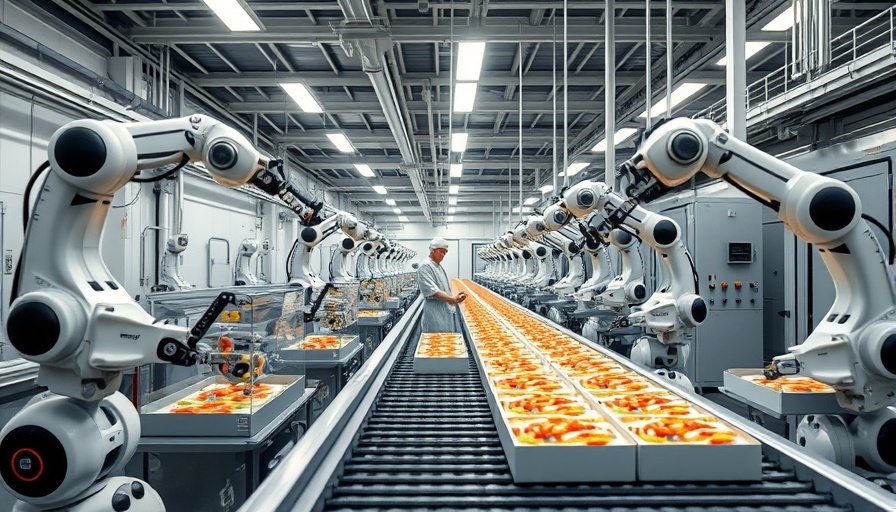
Chef Robotics: A Journey from Setbacks to Success
In the world of emerging technology startups, the story of Chef Robotics stands out as a compelling lesson on resilience and adaptability. Founded by Rajat Bhageria, the company initially plunged into the competitive landscape of food tech robotics, navigating through a myriad of challenges. Just a few years ago, Chef Robotics was on the verge of collapse. “There were a lot of dark periods where I was thinking of giving up,” Bhageria recounted, reflecting on the struggles he faced in the early days.
The Dangers of Sticking to the Original Plan
Bhageria started with a vision to revolutionize the fast-casual restaurant industry, realizing a concept where robots could seamlessly prepare meals without human intervention. However, Chef Robotics encountered a critical hurdle known as the "robotic grasping problem." The complexity involved in designing a robot capable of handling delicate ingredients was underestimated. This not only strained their resources but also forced them into a corner with customers who didn’t understand the emerging challenges.
Despite signing multimillion-dollar contracts with fast-casual restaurants eager for automation, the company was unable to deliver, ultimately encountering significant pushback from its clientele. Bhageria soon realized that trying to cater to these demanding customers was an exercise in futility.
Turning Away to Move Forward
Rather than doubling down on an unfeasible approach, Chef Robotics made a bold decision. They shifted their focus away from existing partners who were unyielding in their expectations and sought new clients with different needs. Bhageria's “epiphany” proved invaluable. “Instead of going bust trying to give existing customers what they wanted, maybe I needed different customers,” he reflected.
This strategic pivot allowed Chef Robotics to gather essential training data through partnerships with more flexible firms interested in exploring smaller-scale robot implementations.
Thriving After Adversity: Key Takeaways for Startups
The transformation of Chef Robotics provides several crucial insights for aspiring entrepreneurs:
- Flexibility is Key: The ability to pivot can save a startup from the brink of collapse. Gathering data and adapting to customer feedback can open new pathways and opportunities.
- Risk Management: Understanding when to say no to customers—even those who bring significant revenue—is essential for long-term sustainability.
- Invest in Niche Solutions: Focusing on specific technological challenges rather than broad applications can lead to innovative breakthroughs.
The Importance of Support and Mentorship
Bhageria credited his friends and investors for encouraging him during the tough times. As an entrepreneur, having a reliable support system is indispensable. Whether through informal mentorship or consulting programs, entrepreneurs can benefit from insights that help navigate challenges on the innovative journey.
Funding Your Startup: Lessons from Chef Robotics
After the pivotal change in strategy, Chef Robotics successfully secured $23 million in a Series A funding round, which played a significant role in stabilizing the company. For other startups in the same boat, this exemplifies the necessity of a solid business startup funding plan. The key components for attracting investors often include:
- A clear and compelling value proposition that resolves a specific issue.
- A scalable business model that can adapt and evolve with ongoing challenges.
- A credible team that demonstrates expertise and resilience.
The Future of Food Tech Robotics
As Chef Robotics continues to grow—boasting 40 employees and producing over 45 million meals—Bhageria's journey serves as a reminder: navigating the landscape of tech business startups is not solely about technology but also the interplay of innovation, market needs, and the adaptability of the founding team. Looking ahead, there are numerous opportunities for tech startups focused on addressing niche challenges in various industries, including agriculture, transportation, and culinary arts.
Conclusion: Embrace Innovation and Learn from Failure
The story of Chef Robotics shows that success isn't linear; it's fraught with obstacles that can either hinder or propel a startup forward. For those eager to embark on their own journey, take a concise approach to the business startup checklist—identify the challenges, assess potential pivots, and build a support system that can help you weather any storm.
If you're inspired by Chef Robotics and are ready to consider starting your own venture, remember that perseverance, a clear vision, and adaptability can lead you towards an innovative path.
 Add Row
Add Row  Add
Add 



Write A Comment